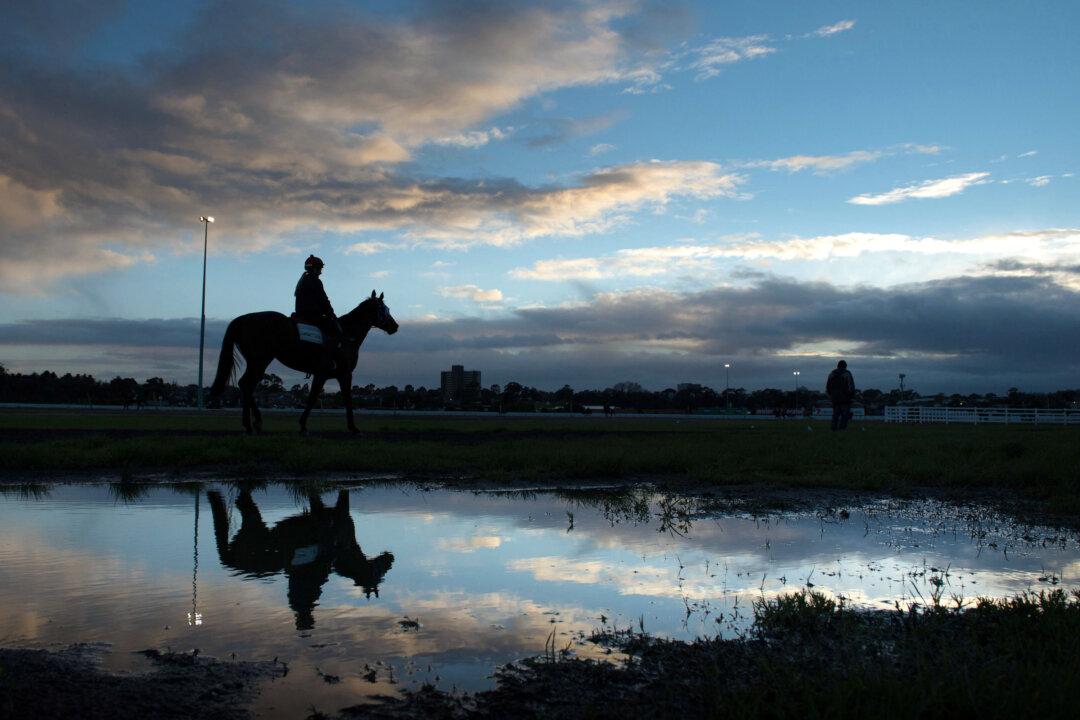MELBOURNE — The Melbourne Cup is the race that stops a nation, where patrons come beautifully dressed, transforming the stands into a sea of colour. Beer and champagne flow and race-goers study the guide, hoping to pick the winners and make it a day to remember.
Flemington Racecourse in the cold hours of early morning, however, reveals another world.
Here at the track the hard work is being done to prepare for the Spring Races and the Melbourne Cup. Trainers and track riders replace fascinators with beanies and helmets, suits and dresses with down jackets, and champagne with hot coffee.
The stands are empty; dimly lit floodlights cast shadows across the track. In the distance, you can just make out the majestic creatures snorting out clouds of vapour, to the rhythmic sounds of turf being pounded. Jockeys bob up and down, like corks in the ocean.
There is a real buzz of movement as Simon Zahra, from Ellerton/Zahra Racing, takes Epoch Times around the track and stables, and into the world of horse racing.
Simon and business partner Mathew Ellerton have been training racehorses for 25 years – more than half their lives. The industry is a year-round, twice a day, seven days a week commitment, with 3am starts. It has to be in your DNA, Simon explains. “This industry is your life, not a job. Once the passion’s in your blood, it is hard to get out.”
Hard Work
Trainers give much of themselves to help mould the horse into a potential champion that will be adored by the nation, but for the trainers themselves the law of averages reveal that these are few and far between. “Not everyone has good horses—maybe you have one or two,” said Simon.
Each day the trainers run the horses through a tight regimen in preparation for the biggest racing days of the year. The intensity of training is gauged according to how much food the horses eat – the more they eat, the harder they’re trained. Their diet consist of oats, maize and miteavite (a protein and vitamin mix) for muscle growth, and chaff for the digestive system. Every facet of the horses’ training program is monitored and evaluated to help provide the best opportunities for the horses to do well on race day.
Before track work begins, the horses are checked over for any niggling injuries before starting their warm up of 30 minutes on a walking machine, which can only be described as a large, slow moving merry-go-round. Coming off the walker, the horses go to the track for their workout of either cantering or galloping, depending on the training week. This rotating system requires twenty-six staff members and continues from around 6am to 9am, until all 50 horses have been worked.
The horses are then fed, re-hydrated and rested. In the afternoon they spend another thirty minutes on the walker to get the blood circulating, aiding their recovery. Sunday is a day of rest.
Simon explains that the process is like training a football team, with a pre-season followed by consistent training sessions leading up to the finals. At the end of season, his team drafts in new horse recruits and transfers out old ones. At the end of the day, he says, it’s a business with many overheads and bills to be paid.
“Training has gone from three days a week to now seven to try and obtain the corporate dollar,” said Simon.
“The industry has changed so much with technology and a lot of the old trainers struggle to keep up with Twitter, Facebook, regular emails, photos and video. You have to employ someone to do it as you move with the times.”
New horse recruits come from all over Australia and New Zealand, with many transported by plane. Plane travel provides moments of tension, Simon admits. “The horses are sedated and always accompanied by a vet, because at the end of the day if a horse goes berserk on a plane, you have to put it down. They can put their head through the roof and the whole plane comes down.”
Over the years, several tragedies have plagued horses bound for the Cup, especially in the old days when boats and ferries where used for transport.
In 1876, nine Sydney racehorses died at sea when a gale turned into a hurricane on their way to Melbourne. That year’s Melbourne Cup favourite, Robin Hood, was among those that drowned or were crushed to death as gigantic swells struck the boat.
Times have changed over the Cup’s 153-year history, with racing now a multimillion dollar industry. In these competitive times, trainers and staff work around the clock to provide racehorses that can compete on the world stage while many horses come from around to world to Melbourne for a chance at the prize.
The Melbourne Cup, part of the six-week Spring Racing Carnival, will take place on Tuesday Nov 5 this year. As author Russell Ward says in The Australian Legend: “The race is run over a few, short furlongs, near Melbourne. Actually, it is run across the hearts of the Australian people.”
